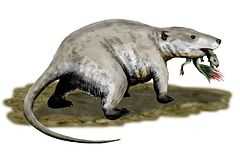Repenomamus
| Repenomamus Temporal range: Early Cretaceous, 125–123.2Ma | |
|---|---|
| | |
| Fossil skull of R. giganticus | |
| Scientific classification | |
| Kingdom: | Animalia |
| Phylum: | Chordata |
| Class: | Mammalia |
| Order: | †Gobiconodonta |
| Family: | †Gobiconodontidae |
| Genus: | †Repenomamus Li et al., 2000 |
| Type species | |
| †Repenomamus robustus Li et al., 2001[1] | |
| Species | |
|
†Repenomamus robustus Li et al., 2000 | |
Repenomamus is a gobiconodontid[2] mammal genus containing two species, Repenomamus robustus and Repenomamus giganticus. Both species are known from fossils found in China that date to the early Cretaceous period, about 125-123.2 million years ago. R. robustus is the only Mesozoic mammal for which there is good evidence that it fed on small vertebrates, including young dinosaurs, though it is not possible to determine if it actively hunted live dinosaurs or scavenged dead ones. R. giganticus is the largest mammal known from the Mesozoic era.
Classification and discovery

The fossils were recovered from the lagerstätte of the Yixian Formation in the Liaoning province of China, which is renowned for its extraordinarily well-preserved fossils of feathered dinosaurs. They have been specifically dated to 125-123.2 million years ago, during the Early Cretaceous period.
Repenomamus is a genus of triconodonts, a group of early mammals with no modern relatives. R. robustus was described by Li, Wang, Wang and Li in 2000, and R. giganticus was described by Hu, Meng, Wang and Li in 2005. The two known species are the sole members of the family Repenomamidae, which was also described in the same paper in 2000. It is sometimes alternatively listed as a member of the family Gobiconodontidae; although this assignment is controversial, a close relationship to this family is well-founded.
Description
Individuals of the known species in Repenomamus are the largest known Mesozoic mammals represented by reasonably complete fossils, adults of R. robustus were the size of a Virginia opossum with an estimated mass of 4–6 kg (8.8–13 lb) while the known adult of R. giganticus was about 50% larger with a total length of around 1 m (3 ft 3 in) and an estimated mass of 12–14 kg (26–31 lb). These finds extend considerably the known body size range of Mesozoic mammals, Repenomamus, in fact, were larger than several sympatric small dromaeosaurid dinosaurs like Graciliraptor.[3] Features of its shoulder and legs bones indicate a sprawling posture as in most of small to medium sized living therian mammals, with plantigrade feet, different from therian mammals however, Repenomamus had proportionally longer bodies with shorter limbs.
Paleobiology

Features of the teeth and jaw suggest that Repenomamus were carnivorous and a specimen of R. robustus discovered with the fragmentary skeleton of a juvenile Psittacosaurus preserved in its stomach represents the first direct evidence that at least some Mesozoic mammals were carnivorous and fed on small vertebrates, including young dinosaurs.[3]
See also
- Mammaliformes
- Cynodonts
- Cynognathus
- Evolution of mammals
References
- ↑ Li et al. (2001). "A new family of primitive mammal from the Mesozoic of western Liaoning, China". Chinese Science Bulletin 46 (9): 782–785. doi:10.1007/bf03187223.
- ↑ Marisol Montellano, James A. Hopson, James M. Clark (2008). "Late Early Jurassic Mammaliaforms from Huizachal Canyon, Tamaulipas, México". Journal of Vertebrate Paleontology 28 (4): 1130–1143. doi:10.1671/0272-4634-28.4.1130.
- ↑ 3.0 3.1 Hu et al. (2005). "Large Mesozoic mammals fed on young dinosaurs". Nature 433 (7022): 149–152. doi:10.1038/nature03102. PMID 15650737.
External links
- "Prehistoric badger had dinosaurs for breakfast". Michael Hopkin. Nature.com. January 12, 2005.
- "Fierce mammal ate dinos for lunch". BBC News. January 12, 2005.